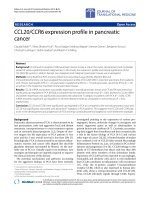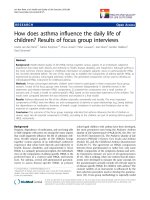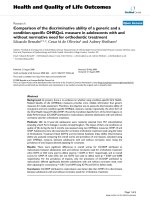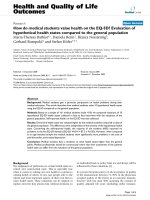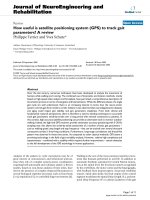Báo cáo hóa học: "How discriminating are discriminative instruments? Matthew Hankins1,2,3" doc
Bạn đang xem bản rút gọn của tài liệu. Xem và tải ngay bản đầy đủ của tài liệu tại đây (179.77 KB, 5 trang )
BioMed Central
Page 1 of 5
(page number not for citation purposes)
Health and Quality of Life Outcomes
Open Access
Review
How discriminating are discriminative instruments?
Matthew Hankins
1,2,3
Address:
1
King's College London, Department of Psychology (at Guy's), Institute of Psychiatry, London, UK,
2
Department of Primary Care & Public
Health, Brighton & Sussex Medical School, Brighton, UK and
3
Brighton & Sussex University Hospitals NHS Trust, Royal Sussex County Hospital,
Brighton, UK
Email: Matthew Hankins -
Abstract
The McMaster framework introduced by Kirshner & Guyatt is the dominant paradigm for the
development of measures of health status and health-related quality of life (HRQL). The framework
defines the functions of such instruments as evaluative, predictive or discriminative. Evaluative
instruments are required to be sensitive to change (responsiveness), but there is no corresponding
index of the degree to which discriminative instruments are sensitive to cross-sectional differences.
This paper argues that indices of validity and reliability are not sufficient to demonstrate that a
discriminative instrument performs its function of discriminating between individuals, and that the
McMaster framework would be augmented by the addition of a separate index of discrimination.
The coefficient proposed by Ferguson (Delta) is easily adapted to HRQL instruments and is a direct,
non-parametric index of the degree to which an instrument distinguishes between individuals.
While Delta should prove useful in the development and evaluation of discriminative instruments,
further research is required to elucidate the relationship between the measurement properties of
discrimination, reliability and responsiveness.
Background
The McMaster framework [1] defines the functions of
health status instruments as evaluative, predictive, or dis-
criminative. Evaluative instruments measure longitudinal
change, typically the effects of treatment. Predictive instru-
ments are used classify individuals against an external cri-
terion and are intended for diagnostic, prognostic or
screening purposes. Discriminative instruments are used to
quantify differences between individuals when no exter-
nal criterion exists, typically in cross-sectional studies.
These functional definitions have been widely adopted as
the methodological basis for the measurement of health-
related quality of life (HRQL) [2].
The validity of a HRQL instrument depends primarily on
the instrument measuring the correct aspect of HRQL [3].
This is usually demonstrated by appropriate correlations
with other measures [4]. Beyond this, the framework spec-
ifies that the necessary measurement properties for valid-
ity depend on the intended function of the instrument [1].
Evaluative instruments are required to give consistent
measurements (reliability) and be sensitive to change
(responsiveness) [3]. Reliability may be estimated by a
variety of methods [4], but for longitudinal consistency
the usual method is a test-retest correlation or intra-class
correlation (ICC) [3]. Responsiveness is usually indexed
by a mean difference adjusted for variance (for example,
Cohen's d or the standardised response mean [5]).
Discriminative instruments, in contrast, are required only
to be reliable. Since they are used primarily in cross-sec-
Published: 27 May 2008
Health and Quality of Life Outcomes 2008, 6:36 doi:10.1186/1477-7525-6-36
Received: 31 October 2007
Accepted: 27 May 2008
This article is available from: />© 2008 Hankins; licensee BioMed Central Ltd.
This is an Open Access article distributed under the terms of the Creative Commons Attribution License ( />),
which permits unrestricted use, distribution, and reproduction in any medium, provided the original work is properly cited.
Health and Quality of Life Outcomes 2008, 6:36 />Page 2 of 5
(page number not for citation purposes)
tional samples, reliability is commonly estimated using
cross-sectional data, typically Cronbach's Alpha (a two-
way mixed effects ICC [6]). If longitudinal data are avail-
able, another estimate may be derived from the test-retest
correlation or ICC [6]. As discriminative instruments are
not used to measure change, they are not required to be
responsive [3].
The reliability of an evaluative instrument does not tell us
how sensitive it is to longitudinal differences [3]. Simi-
larly, it may be argued that the reliability of a discrimina-
tive instrument fails to tell us how sensitive it is to cross-
sectional differences. For example, an instrument might
consistently fail to discriminate between people (reliable
but not discriminating), or discriminate well, but incon-
sistently (discriminating but not reliable). This paper pro-
poses therefore that the McMaster framework would be
augmented by an additional index of discrimination. The
implications of such an index for the development of dis-
criminative instruments will be discussed, with examples.
Indices of discrimination
The sort of discrimination required of discriminative
instruments is known in the classical psychometric litera-
ture as test discrimination [7]. This is the ability of a psycho-
metric test to be able to distinguish between individuals
without reference to an external criterion. In contrast, dis-
criminant validity requires an external criterion, which is
more consistent with the framework's definition of a pre-
dictive instrument [4], and item discrimination refers to the
difficulty of each item of the test [8,9].
The earliest attempts to describe test discrimination were
based on 'cumulative' scales such as Guttman scales [10].
Walker [11] and Loevinger [12,13] developed coefficients
to describe the degree to which the scale approached the
psychometric ideal that a score of n indicated that the least
difficult n items had been answered correctly, and no oth-
ers. Taking an atheoretical approach, Thurlow [14,15] and
Ferguson [7] both recognised that for a given sample size
there would be a maximum possible number of differ-
ences that might be observed. This could be compared
with the number of differences actually observed and
expressed as a ratio: the coefficient of discrimination.
Thurlow seems to have been the first to recognise the dis-
tinction between discrimination and reliability, but
despite presenting the coefficient (and modifications of
it) earlier and treating the issue of discrimination in con-
siderably more depth, it is commonly referred to as "Fer-
guson's Delta" [4].
Ferguson's Delta is the ratio of the observed between-per-
sons differences to the maximum number possible. If no
differences are observed, then Delta = 0.0; if all possible
between-person discriminations are made, then Delta =
1.0. Delta is not restricted to Guttman scales and is non-
parametric, being based solely on the ordinal properties
of the data. It has one limitation that has restricted its use
with a wider range of questionnaire measures: the scale
must comprise dichotomous (binary) items. Fortunately,
this limitation is easily overcome [16] making Delta more
widely applicable to HRQL instruments.
Calculation of Delta
Ferguson's original formula (simplified by Guilford [17])
is appropriate for scales with dichotomous items:
where k is the number of items, n is the sample size and f
is the frequency of each score i (with i ranging from 0 to
k).
For scales with more than two response options (such as
Likert scales), the modified formula should be used [16]:
where m is the number of item responses and all other
terms remain the same. For a typical Likert scale, m = 5.
The calculation of Delta is relatively straightforward: an
Excel spreadsheet is available, as well as program code in
R (with bootstrapped 95% confidence limits) and Stata
[16].
Examples of discrimination analysis
Example 1: worked calculation of Delta
To illustrate the calculation of Delta, consider two equally
valid single-item Likert instruments, Scale A and Scale B,
d
=
+−
∑
()( )kn f
i
i
kn
1
22
2
(1)
d
=
+− −
∑
−
( ( ))( )
()
11
22
2
1
km n f
i
i
nkm
(2)
Table 1: Hypothetical data for two single-item Likert
instruments (n = 10)
Scale A Scale B
Score i Frequency f
i
Score i Frequency f
i
1111864
224200
3416311
424400
511511
Sum 26 66
f
i
2
f
i
2
Health and Quality of Life Outcomes 2008, 6:36 />Page 3 of 5
(page number not for citation purposes)
given to 10 people known to differ in HRQL. Responses to
Scale A are 1,2,2,3,3,3,3,4,4,5 and responses to Scale B are
1,1,1,1,1,1,1,1,3,5. The scales agree substantially (ICC =
0.83). Since the scale is not dichotomous, formula (2) is
required, with values k = 1, m = 5 and n = 10.
Table 1 gives the frequency tables for Scales A and B. It
should be obvious that, despite their high concordance,
Scale B is the less discriminating of the two, since eight
people are not discriminated from each other (all scoring
1). From the formula, Scale A Delta = (1+4) * (100-26)/
400 = 0.925, and for Scale B Delta = (1+4)*(100-66)/400
= 0.425. Hence, Scale A makes 92.5% of all possible dis-
criminations, while Scale B makes only 42.5% of all pos-
sible discriminations: Scale A is almost twice as
discriminating as Scale B. Ferguson [7] suggested that a
normal distribution would be expected to have discrimi-
nation of Delta > 0.90, with lower discrimination
expected for leptokurtic and skewed distributions (since
leptokurtic distributions fail to discriminate around the
mean, while skewed distributions fail to discriminate at
one end of the distribution). On this basis, Scale A shows
good discrimination while Scale B shows poor discrimina-
tion.
Example 2: reliability and discrimination of self-report instruments
For further examples, data were obtained for the 2004
cohort of the Health Survey for England (HSE [18]: usage
ID 21697). Details of sampling and methodology are
publicly available and the data are used here for demon-
stration only. Since the HSE samples by household, the
records were filtered to produce a dataset of the 4000 'ref-
erence' adults in the household to ensure that the data
were independent.
The HSE includes a number of self report instruments of
interest to HRQL researchers: Table 2 shows those selected
for this analysis, describing the number of items (k),
number of item response options (m) and the number of
people completing (n). For the purposes of demonstra-
tion, a range of instruments was chosen: a single-item Lik-
ert-type scale (self-reported health), a multi-item scale
with dichotomous response options (GHQ-12 [19]), a
multi-item scale with polytomous response options (Per-
ceived Social Support [20]) and a non-summative multi-
item scale with polytomous response options (EuroQoL
[21]).
Since the data were cross-sectional, reliability was esti-
mated using Cronbach's Alpha. Alpha and Delta values
are also presented in Table 2. For the single item self-
reported health instrument it was not possible to compute
Alpha; the value for Delta, however, suggested that the
instrument was discriminating, with 84% of possible dis-
criminations being made. The reliability of the GHQ-12
(scored dichotomously) was acceptable (Alpha = 0.88),
but discrimination was poor (Delta = 0.63) with less than
two thirds of possible discriminations being made. A sim-
ilar result was found for the Perceived Social Support
instrument: acceptable reliability (Alpha = 0.88) but poor
discrimination (Delta = 0.64). The EuroQol instrument
demonstrates the versatility of Delta as an index of dis-
crimination. The EuroQol assess quality of life in five
dimensions using five items, each with three response
options coded 1 to 3. Responses to each item are not
summed in the usual manner but are used to describe a
unique 'health state': for example 11111 is a different
health state to 11221. Since there are five items each with
three responses, there are 243 possible health states, rang-
ing from 11111 (best) to 33333 (worst). Although Alpha
may be calculated to demonstrate the consistency of
responses to items, it describes the reliability of the
summed score, not the classification of health state. Delta,
however, may still be used since different health states
may be discriminated from each other. The EuroQol
showed acceptable reliability for the summed score
(Alpha = 0.77), but less than optimal discrimination
between health states (Delta = 0.71).
Example 3: instrument development
The tabulated data (Table 3) show item scores, reliability
and discrimination for an eight item dichotomous test of
numeracy. Also shown are the reliability and discrimina-
tion of the instrument when each item is removed. The
data were obtained as part of a study of health-related
numeracy [22] unrelated to this paper and are used for
illustration only. Once again the data are cross-sectional
and Alpha is used as an estimate of reliability. Dichoto-
mously-scored instruments are not common in HRQL
measurement, but the principles illustrated here apply
equally to Likert-type scoring.
Table 2: Selected self-report instruments from the Health Survey for England (2004 cohort, N = 4000)
Scale Number of Items (k) Number of response options (m) Number completing (n) Alpha Delta
Self-reported health 1 5 3997 - 0.84
GHQ-12 12 2 3705 0.88 0.63
Perceived Social Support 7 3 3730 0.88 0.64
EuroQol 5 3 3679 0.77 0.71
Health and Quality of Life Outcomes 2008, 6:36 />Page 4 of 5
(page number not for citation purposes)
The problem considered is that of item reduction: a
researcher is required to shorten the instrument from
eight items to four to alleviate the burden on respondents.
Three alternative short forms of the instrument (A, B and
C) are presented in Table 3 with their reliability and dis-
crimination coefficients.
Short form A is the instrument that results from retaining
items solely for their impact on reliability (items Q3 to
Q6). This has the effect of increasing reliability (Alpha =
0.85), but drastically decreasing discrimination (Delta =
0.56). The selection of items solely on the basis that they
are highly consistent with each other results in a discrim-
inative instrument that makes only 56% of the possible
number of discriminations.
In contrast, short form B is the instrument that results
from retaining items solely for their impact on discrimina-
tion (items Q1, Q2, Q7 and Q8). This maintains the dis-
crimination of the instrument (Delta = 0.95) but
decreases reliability to an unacceptable level (Alpha =
0.51).
A compromise is required: short form C comprises items
selected on the basis of their impact on both reliability
and discrimination. Note that this entails a slight loss of
both reliability (Alpha = 0.72) and discrimination (Delta
= 0.82). Whether or not these indices are sufficient for a
specific research project is, of course, a matter for the
judgement of the researcher. However, the point should
be clear that neither A nor B is likely to be a valid instru-
ment in terms of both reliability and discrimination.
Conclusion
It seems that the McMaster framework would be aug-
mented by considering the discrimination of discrimina-
tive instruments. The results presented here demonstrate
that reliable measures may fail to discriminate adequately,
and developing measures solely to maximise internal reli-
ability may be counterproductive.
That this aspect of the framework has been neglected may
be due to the emphasis in HRQL research on measuring
change; hence the focus has been on evaluative instru-
ments, their responsiveness, and refining indices of
responsiveness. In other words, if discriminative instru-
ments are rarely developed, then it should not be surpris-
ing if little attention has been given to indices of
discrimination. The relationship between reliability,
validity, responsiveness and discrimination is largely
unexplored, particularly for longitudinal measurements.
Further research is required into the measurement proper-
ties of existing HRQL instruments and the development of
new ones. It is hoped that the outline and examples given
here will help researchers achieve this aim.
Abbreviations
GHQ-12: General Health Questionnaire (12-item ver-
sion); HRQL: Health-related quality of life; HSE: Health
Survey for England; ICC: Intraclass correlation coefficient.
Competing interests
The author declares that he has no competing interests.
Authors' contributions
MH was the sole author.
Acknowledgements
Thanks to Dr. Jim Martin, Virginia Academy of Science, for retrieving the
abstract of Willard R. Thurlow's presentation to the Academy.
References
1. Kirshner B, Guyatt G: A methodological framework for assess-
ing health indices. J Chronic Dis 1985, 38(1):27-36.
2. Norman GR, Wyrwich KW, Patrick DL: The mathematical rela-
tionship among different forms of responsiveness coeffi-
cients. Qual Life Res 2006, 16(5):815-822.
3. Guyatt G, Kirshner B, Jaeschke R: Measuring health status: what
are the necessary measurement properties? J Clin Epidemiol
1992, 45(12):1341-1345.
4. Kline P: The handbook of psychological testing. 2nd edition.
Routledge, London; 2000.
5. Terwee CB, Dekker FW, Wiersinga WM, Prummel MF, Bossuyt
PMM: On assessing responsiveness of health-related quality of
Table 3: Reliability and discrimination of the eight item Lipkus numeracy scale (N = 140)
Item Alpha if item Delta if item Delta for item Short form A Short form B Short form C
deleted deleted
Q1 0.74 0.88 0.97 + +
Q2 0.77 0.90 0.72 +
Q3 0.71 0.92 0.49 + +
Q4 0.70 0.91 0.71 + +
Q5 0.71 0.92 0.40 + +
Q6 0.71 0.92 0.43 +
Q7 0.74 0.91 0.72 +
Q8 0.76 0.85 0.99 +
Scale Alpha 0.76 0.85 0.51 0.72
Scale Delta 0.92 0.56 0.95 0.82
Publish with BioMed Central and every
scientist can read your work free of charge
"BioMed Central will be the most significant development for
disseminating the results of biomedical research in our lifetime."
Sir Paul Nurse, Cancer Research UK
Your research papers will be:
available free of charge to the entire biomedical community
peer reviewed and published immediately upon acceptance
cited in PubMed and archived on PubMed Central
yours — you keep the copyright
Submit your manuscript here:
/>BioMedcentral
Health and Quality of Life Outcomes 2008, 6:36 />Page 5 of 5
(page number not for citation purposes)
life instruments: Guidelines for instrument evaluation. Qual
Life Res 2003, 12(4):349-362.
6. Cronbach LJ: Test reliability, its meaning and determination.
Psychometrika 1947, 12:1-16.
7. Ferguson GA: On the theory of test discrimination. Psy-
chometrika 1949, 14:61-68.
8. Milholland JE: The reliability of test discriminations. Educational
and Psychological Measurement 1955:362-375.
9. Allen MJ, Yen WM: Introduction to measurement theory.
Monterey, CA: Brooks/Cole; 1979.
10. Guttman L: A basis for scaling qualitative data. American Socio-
logical Review 1944, 9:139-150.
11. Walker DA: Answer-pattern and score-scatter in tests and
examinations. British Journal of Psychology 1931, 22:73-86.
12. Loevinger J: The technic of homogeneous tests compared with
some aspects of scale analysis and factor analysis. Psychological
Bulletin 1948, 45:507-529.
13. Loevinger J, Gleser CG, DuBois PH: Maximising the discriminat-
ing power of a multiple score-test. Psychometrika 1953,
18(4):309-317.
14. Thurlow WR: A problem in test reliability. Proceedings of the Vir-
ginia Academy of Science . 1947–1948, Abstract 5
15. Thurlow W: Direct measures of discriminations among indi-
viduals performed by psychological tests. Journal of Psychology
1950, 29:281-314.
16. Hankins M: Questionnaire discrimination: (re)-introducing
coefficient Delta. BMC Medical Research Methodology 2007, 7:19.
17. Guilford JP: Psychometric Methods. McGraw-Hill, New York;
1954.
18. National Centre for Social Research and University College London:
Department of Epidemiology and Public Health, Health Sur-
vey for England, 2004 [computer file].
Colchester, Essex: UK
Data Archive [distributor]; 2006. SN: 5439
19. Goldberg DP, Williams P: A User's Guide to the General Health
Questionnaire. Windsor: NFER-Nelson; 1988.
20. Bajekal M, Purdon : Social capital and social exclusion: develop-
ment of a condensed module for the Health Survey for Eng-
land. National Centre for Social Research, London, UK; 2001.
21. Brooks R: EuroQol: the current state of play. Health Policy 1996,
37(1):53-72.
22. Wright A, Whitwell SCL, Takeichi C, Hankins M, Marteau T: The
impact of numeracy on reactions to different risk presenta-
tion formats. British Journal of Health Psychology in press.


